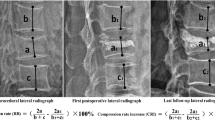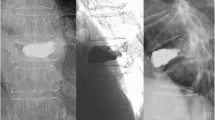Abstract
Percutaneous vertebroplasty is an efficient procedure to treat pain due to osteoporotic vertebral compression fractures. However, refracture of cemented vertebrae occurs occasionally after vertebroplasty. It is unclear whether such fractures are procedure-related or part of the natural course of osteoporosis. The effect of potentially important covariates on refracture risk in cemented vertebrae has not been evaluated previously. We retrospectively analyzed the incidence and possible causative mechanism of refracture in patients who had received only one vertebroplasty for a single level of vertebral compression fracture. We assessed the following covariates: age, sex, body weight, height, lumbar spine bone mineral density, treated vertebral level, pre-existing untreated vertebral compression fracture, and gas-containing vertebrae before treatment. Surgical variables, including surgical approach, cement injected, and anterior vertebral height restoration, were also analyzed. Anti-osteoporotic treatment after surgery was recorded. Multiple logistic regression analysis was used to determine the relative risk of refractures of cemented vertebrae. Over all, 98 patients were evaluated with a mean follow-up of 26.9 ± 12.4 months (range, 7–55 months). We identified 62 refractures and the mean loss of anterior vertebral height was 13.3% (range 3.2–40.3%). The greater the anterior vertebral height obtained from vertebroplasty, the greater the risk of refracture occurring (P < 0.01). Gas-containing vertebrae were also prone to refracture after the procedure (P = 0.01). Anti-osteoporotic treatment was of borderline significance between refractured and non-refractured vertebrae (P = 0.07). Only restoration of anterior vertebral height was positively associated with refracture during the follow-ups (P < 0.01). In conclusion, refractures of cemented vertebrae after vertebroplasty occurred in 63% of osteoporotic patients. Significant anterior vertebral height restoration increases the risk of subsequent fracture in cemented vertebrae.


Similar content being viewed by others
References
Belkoff SM, Mathis JM, Jasper LE et al (2001) The biomechanics of vertebroplasty: the effect of cement volume on mechanical behavior. Spine 26(14):1537–1541
Berlemann U, Ferguson SJ, Nolte LP et al (2002) Adjacent vertebral failure after vertebroplasty: a biomechanical investigation. J Bone Joint Surg Br 84(5):748–752
Black DM, Cummings SR, Karpf DB et al (1996) Randomised trial of effect of alendronate on risk of fracture in women with existing vertebral fractures. Fracture Intervention Trial Research Group. Lancet 348(9041):1535–1541
Cotten A, Dewatre F, Cortet B et al (1996) Percutaneous vertebroplasty for osteolytic metastases and myeloma: effects of the percentage of lesion filling and the leakage of methyl methacrylate at clinical follow-up. Radiology 200(2):525–530
Dansie DM, Luetmer PH, Lane JI et al (2005) MRI findings after successful vertebroplasty. AJNR Am J Neuroradiol 26(6):1595–1600
Dean JR, Ison KT, Gishen P (2000) The strengthening effect of percutaneous vertebroplasty. Clin Radiol 55(6):471–476
Delmas PD, Genant HK, Crans GG et al (2003) Severity of prevalent vertebral fractures and the risk of subsequent vertebral and nonvertebral fractures: results from the MORE trial. Bone 33(4):522–532
Ettinger B, Black DM, Mitlak BH et al (1999) Reduction of vertebral fracture risk in postmenopausal women with osteoporosis treated with raloxifene: results from a 3-year randomized clinical trial. Multiple Outcomes of Raloxifene Evaluation (MORE) Investigators. JAMA 282(7):637–645
Garfin SR, Yuan HA, Reiley MA (2001) New technologies in spine: kyphoplasty and vertebroplasty for the treatment of painful osteoporotic compression fractures. Spine 26(14):1511–1515
Hiwatashi A, Moritani T, Numaguchi Y et al (2003) Increase in vertebral body height after vertebroplasty. AJNR Am J Neuroradiol 24(2):185–189
Jensen ME, Evans AJ, Mathis JM et al (1997) Percutaneous polymethylmethacrylate vertebroplasty in the treatment of osteoporotic vertebral body compression fractures: technical aspects. AJNR Am J Neuroradiol 18(10):1897–1904
Kim SH, Kang HS, Choi JA et al (2004) Risk factors of new compression fractures in adjacent vertebrae after percutaneous vertebroplasty. Acta Radiol 45(4):440–445
Komemushi A, Tanigawa N, Kariya S et al (2006) Percutaneous vertebroplasty for osteoporotic compression fracture: multivariate study of predictors of new vertebral body fracture. Cardiovasc Intervent Radiol 29(4):580–585
Lane JI, Maus TP, Wald JT et al (2002) Intravertebral clefts opacified during vertebroplasty: pathogenesis, technical implications, and prognostic significance. AJNR Am J Neuroradiol 23(10):1642–1646
Liberman UA, Weiss SR, Broll J et al (1995) Effect of oral alendronate on bone mineral density and the incidence of fractures in postmenopausal osteoporosis. The Alendronate Phase III Osteoporosis Treatment Study Group. N Engl J Med 333(22):1437–1443
Liebschner MA, Rosenberg WS, Keaveny TM (2001) Effects of bone cement volume and distribution on vertebral stiffness after vertebroplasty. Spine 26(14):1547–1554
Lin EP, Ekholm S, Hiwatashi A et al (2004) Vertebroplasty: cement leakage into the disc increases the risk of new fracture of adjacent vertebral body. AJNR Am J Neuroradiol 25(2):175–180
Lin WC, Chen SH, Cheng TT et al (2004) The role of imaging studies of percutaneous vertebroplasty in 63 patients with osteoporotic compression fracture: preliminary report. Chin J Radiol 29:177–184
Lindsay R, Silverman SL, Cooper C et al (2001) Risk of new vertebral fracture in the year following a fracture. JAMA 285(3):320–323
McKiernan F, Faciszewski T (2003) Intravertebral clefts in osteoporotic vertebral compression fractures. Arthritis Rheum 48(5):1414–1419
McKiernan F, Faciszewski T, Jensen R (2005) Does vertebral height restoration achieved at vertebroplasty matter? J Vasc Interv Radiol 16(7):973–979
McKiernan F, Faciszewski T, Jensen R (2004) Quality of life following vertebroplasty. J Bone Joint Surg Am 86-A(12):2600–2606
McKiernan F, Faciszewski T, Jensen R (2003) Reporting height restoration in vertebral compression fractures. Spine 28(22):2517–2521
McKiernan F, Jensen R, Faciszewski T (2003) The dynamic mobility of vertebral compression fractures. J Bone Miner Res 18(1):24–29
Molloy S, Mathis JM, Belkoff SM (2003) The effect of vertebral body percentage fill on mechanical behavior during percutaneous vertebroplasty. Spine 28(14):1549–1554
Peh WC, Gelbart MS, Gilula LA et al (2003) Percutaneous vertebroplasty: treatment of painful vertebral compression fractures with intraosseous vacuum phenomena. AJR Am J Roentgenol 180(5):1411–1417
Perez-Higueras A, Alvarez L, Rossi RE et al (2002) Percutaneous vertebroplasty: long-term clinical and radiological outcome. Neuroradiology 44(11):950–954
Polikeit A, Nolte LP, Ferguson SJ (2003) The effect of cement augmentation on the load transfer in an osteoporotic functional spinal unit: finite-element analysis. Spine 28(10):991–996
Rico H, Revilla M, Villa LF et al (1992) Crush fracture syndrome in senile osteoporosis: a nutritional consequence? J Bone Miner Res 7(3):317–319
Teng MM, Wei CJ, Wei LC et al (2003) Kyphosis correction and height restoration effects of percutaneous vertebroplasty. AJNR Am J Neuroradiol 24(9):1893–1900
Trout AT, Kallmes DF, Lane JI et al (2006) Subsequent vertebral fractures after vertebroplasty: association with intraosseous clefts. AJNR Am J Neuroradiol 27(7):1586–1591
Voormolen MH, Lohle PN, Juttmann JR et al (2006) The risk of new osteoporotic vertebral compression fractures in the year after percutaneous vertebroplasty. J Vasc Interv Radiol 17(1):71–76
Author information
Authors and Affiliations
Corresponding author
Rights and permissions
About this article
Cite this article
Lin, WC., Lee, YC., Lee, CH. et al. Refractures in cemented vertebrae after percutaneous vertebroplasty: a retrospective analysis. Eur Spine J 17, 592–599 (2008). https://doi.org/10.1007/s00586-007-0564-y
Received:
Revised:
Accepted:
Published:
Issue Date:
DOI: https://doi.org/10.1007/s00586-007-0564-y




